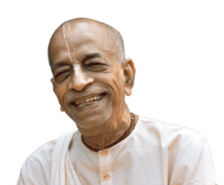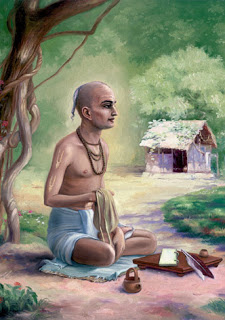
Submitted by: Yasoda nandana Dasa
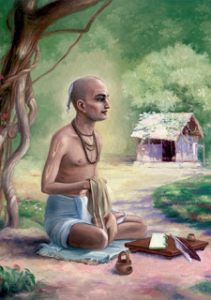
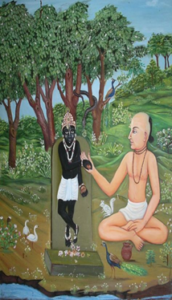
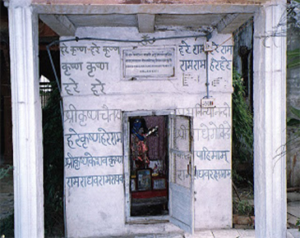
Srila Sanatana Goswami Tirobhava Tithi [disappearance day]
First Month of Caturmasa
Vyasa-Purnima
Tuesday, July 19, 2016 Mayapura, West Bengal time]
anupama-vallabha, śrī-rūpa, sanātana
ei tina śākhā vṛkṣera paścime sarvottama
SYNONYMS
anupama—of the name Anupama; vallabha—of the name Vallabha; śrī-rūpa—of the name Śrī Rūpa; sanātana—of the name Sanātana; ei—these; tina—three; śākhā—branches; vṛkṣera—of the tree; paścime—on the western side; sarvottama—very great.
TRANSLATION
On the western side were the forty-third, forty-fourth and forty-fifth branches-Śrī Sanātana, Śrī Rūpa and Anupama. They were the best of all.
PURPORT
Śrī Anupama was the father of Śrīla Jīva Gosvāmī and youngest brother of Śrī Sanātana Gosvāmī and Śrī Rūpa Gosvāmī. His former name was Vallabha, but after Lord Caitanya met him He gave him the name Anupama. Because of working in the Muslim government, these three brothers were given the title Mullik. Our personal family is connected with the Mulliks of Mahatma Gandhi Road in Calcutta, and we often used to visit their Rādhā-Govinda temple. They belong to the same family as we do. (Our family gotra, or original genealogical line, is the Gautama-gotra, or line of disciples of Gautama Muni, and our surname is De.) But due to their accepting the posts of Zamindars in the Muslim government, they received the title Mullik. Similarly, Rūpa, Sanātana and Vallabha were also given the title Mullik. Mullik means “lord.” Just as the English government gives rich and respectable persons the title “lord,” so the Muslims give the title Mullik to rich, respectable families that have intimate connections with the government. The title Mullik is found not only among the Hindu aristocracy but also among Muslims. This title is not restricted to a particular family but is given to different families and castes. The qualifications for receiving it are wealth and respectabilityi
Sanātana Gosvāmī and Rūpa Gosvāmī belonged to the Bharadvāja-gotra, which indicates that they belonged either to the family or disciplic succession of Bharadvāja Muni. As members of the Kṛṣṇa consciousness movement we belong to the family, or disciplic succession, of Sarasvatī Gosvāmī, and thus we are known as Sārasvatas. Obeisances are therefore offered to the spiritual master as sārasvata-deva, or a member of the Sārasvata family (namas te sārasvate deve), whose mission is to broadcast the cult of Śrī Caitanya Mahāprabhu (gaura-vāṇī-pracāriṇe) and to fight with impersonalists and voidists (nirviśeṣa-śūnyavādi-pāścātya-deśa-tāriṇe). This was also the occupational duty of Sanātana Gosvāmī, Rūpa Gosvāmī and Anupama Gosvāmī.
The genealogical table of Sanātana Gosvāmī, Rūpa Gosvāmī and Vallabha Gosvāmī can be traced back to the twelfth century śakābda, when a gentleman of the name Sarvajña appeared in a very rich and opulent brāhmaṇa family in the province of Karṇāṭa. He had two sons, named Aniruddhera Rūpeśvara and Harihara, who were both bereft of their kingdoms and thus obliged to reside in the highlands. The son of Rūpeśvara, who was named Padmanābha, moved to a place in Bengal known as Naihāṭī on the bank of the Ganges. There he had five sons, of whom the youngest, Mukunda, had a well-behaved son named Kumāradeva, who was the father of Rūpa, Sanātana and Vallabha. Kumāradeva lived in Bāklācandradvīpa, which was in the district of Jessore and is now known as Phateyābād. Of his many sons, three took to the path of Vaiṣṇavism. Later, Śrī Vallabha and his elder brothers Śrī Rūpa and Sanātana came from Candradvīpa to the village in the Maldah district of Bengal known as Rāmakeli. It is in this village that Śrīla Jīva Gosvāmī took birth, accepting Vallabha as his father. Because of engaging in the service of the Muslim government, the three brothers received the title Mullik. When Lord Caitanya Mahāprabhu visited the village of Rāmakeli, He met Vallabha there. Later, Śrī Rūpa Gosvāmī, after meeting Śrī Caitanya Mahāprabhu, resigned from government service, and when he went to Vṛndāvana to meet Lord Caitanya, Vallabha accompanied him. The meeting of Rūpa Gosvāmī and Vallabha with Caitanya Mahāprabhu at Allahabad is described in the Madhya-līlā, Chapter Nineteen.
Actually, it is to be understood from the statement of Sanātana Gosvāmī that Śrī Rūpa Gosvāmī and Vallabha went to Vṛndāvana under the instructions of Śrī Caitanya Mahāprabhu. First they went to Mathurā, where they met a gentleman named Subuddhi Rāya, who maintained himself by selling dry fuel wood. He was very pleased to meet Śrī Rūpa Gosvāmī and Anupama, and he showed them the twelve forests of Vṛndāvana. Thus they lived in Vṛndāvana for one month and then again went to search for Sanātana Gosvāmī. Following the course of the Ganges, they reached Allahabad, or Prayāga-tīrtha, but because Sanātana Gosvāmī had come there by a different road, they did not meet him there, and when Sanātana Gosvāmī came to Mathurā he was informed of the visit of Rūpa Gosvāmī and Anupama by Subuddhi Rāya. When Rūpa Gosvāmī and Anupama met Caitanya Mahāprabhu at Benares, they heard about Sanātana Gosvāmī’s travels from Him, and thus they returned to Bengal, adjusted their affairs with the state and, on the order of Śrī Caitanya Mahāprabhu, went to see the Lord at Jagannātha Purī.
In the year 1436 śakābda (A.D. 1515), the youngest brother, Anupama, died and went back home, back to Godhead. He went to the abode in the spiritual sky where Śrī Rāmacandra is situated. At Jagannātha Purī, Śrī Rūpa Gosvāmī informed Śrī Caitanya Mahāprabhu of this incident. Vallabha was a great devotee of Śrī Rāmacandra; therefore he could not seriously consider the worship of Rādhā-Govinda according to the instructions of Śrī Caitanya Mahāprabhu. Yet he directly accepted Śrī Caitanya Mahāprabhu as an incarnation of the Supreme Personality of Godhead Rāmacandra. In the Bhakti-ratnākara there is the following statement: “Vallabha was given the name Anupama by Śrī Gaurasundara, but he was always absorbed in the devotional service of Lord Rāmacandra. He did not know anyone but Śrī Rāmacandra, but he knew that Caitanya Gosāñi was the same Lord Rāmacandra.”
In the Gaura-gaṇoddeśa-dīpikā (180) Śrī Rūpa Gosvāmī is described to be the gopī named Śrī Rūpa-mañjarī. In the Bhakti-ratnākara there is a list of the books Śrī Rūpa Gosvāmī compiled. Of all his books, the following sixteen are very popular among Vaiṣṇavas: (1) Haṁsadūta, (2) Uddhava-sandeśa, (3) Kṛṣṇa-janma-tithi-vidhi, (4 and 5) Rādhā-kṛṣṇa-gaṇoddeśa-dīpikā, Bṛhat (major) and Laghu (minor), (6) Stavamālā, (7) Vidagdha-mādhava, (8) Lalita-mādhava, (9) Dāna-keli-kaumudi, (10) Bhakti-rasāmṛta-sindhu (this is the most celebrated book by Śrī Rūpa Gosvāmī), (11) Ujjvala-nīlamaṇi, (12) Ākhyāta-candrikā, (13) Mathurā-mahimā, (14) Padyāvalī, (15) Nāṭaka-candrikā and (16) Laghu-bhāgavatāmṛta. Śrī Rūpa Gosvāmī gave up all family connections, joined the renounced order of life and divided his money, giving fifty percent to the brāhmaṇas and Vaiṣṇavas and twenty-five percent to his kuṭumba (family members) and keeping twenty-five percent for personal emergencies. He met Haridāsa Ṭhākura in Jagannātha Purī, where he also met Lord Caitanya and His other associates. Śrī Caitanya Mahāprabhu used to praise the handwriting of Rūpa Gosvāmī. Śrīla Rūpa Gosvāmī could compose verses according to the desires of Śrī Caitanya Mahāprabhu, and by His direction he wrote two books named Lalita-mādhava and Vidagdha-mādhava. Lord Caitanya desired the two brothers, Sanātana Gosvāmī and Rūpa Gosvāmī, to publish many books in support of the Vaiṣṇava religion. When Sanātana Gosvāmī met Śrī Caitanya Mahāprabhu, the Lord advised him also to go to Vṛndāvana.
Śrī Sanātana Gosvāmī is described in the Gaura-gaṇoddeśa-dīpikā (181). He was formerly known as Rati-mañjarī or sometimes Lavaṅga-mañjarī. In the Bhakti-ratnākara it is stated that his spiritual master, Vidyāvācaspati, sometimes stayed in the village of Rāmakeli, and Sanātana Gosvāmī studied all the Vedic literature from him. He was so devoted to his spiritual master that this cannot be described. According to the Vedic system, if someone sees a Muslim he must perform rituals to atone for the meeting. Sanātana Gosvāmī always associated with Muslim kings. Not giving much attention to the Vedic injunctions, he used to visit the houses of Muslim kings, and thus he considered himself to have been converted into a Muslim. He was therefore always very humble and meek. When Sanātana Gosvāmī presented himself before Lord Caitanya Mahāprabhu, he admitted, “I am always in association with lower-class people, and my behavior is therefore very abominable.” He actually belonged to a respectable brāhmaṇa family, but because he considered his behavior to be abominable, he did not try to place himself among the brāhmaṇas but always remained among people of the lower castes. He wrote the Hari-bhakti-vilāsa and Vaiṣṇava-toṣaṇī, which is a commentary on the Tenth Canto of Śrīmad-Bhāgavatam. In the year 1476 śakābda (A.D. 1555) he completed the Bṛhad-vaiṣṇava-toṣaṇī commentary on Śrīmad-Bhāgavatam. In the year 1504 śakābda (A.D. 1583) he finished the Laghu-toṣaṇī.
Śrī Caitanya Mahāprabhu taught His principles through four chief followers. Among them, Rāmānanda Rāya is exceptional, for through him the Lord taught how a devotee can completely vanquish the power of Cupid. By Cupid’s power, as soon as one sees a beautiful woman he is conquered by her beauty. Śrī Rāmānanda Rāya, however, vanquished Cupid’s pride. Indeed, while rehearsing the Jagannātha-vallabha-nāṭaka he personally directed extremely beautiful young girls in dancing, but he was never affected by their youthful beauty. Śrī Rāmānanda Rāya personally bathed these girls, touching them and washing them with his own hands, yet he remained calm and passionless, as a great devotee should be. Lord Caitanya Mahāprabhu certified that this was possible only for Rāmānanda Rāya. Similarly, Dāmodara Paṇḍita was notable for his objectivity as a critic. He did not even spare Caitanya Mahāprabhu from his criticism. This also cannot be imitated by anyone else. Haridāsa Ṭhākura is exceptional for his forbearance because although he was beaten with canes in twenty-two marketplaces, nevertheless he was tolerant. Similarly, Śrī Sanātana Gosvāmī, although he belonged to a most respectable brāhmaṇa family, was exceptional for his humility and meekness.
In the Madhya-līlā, Chapter Nineteen, the device adopted by Sanātana Gosvāmī to get free from the government service is described. He served a notice of sickness to the Nawab, the Moslem governer, but actually he was studying Śrīmad-Bhāgavatam with brāhmaṇas at home. The Nawab received information of this through a royal physician, and he immediately went to see Sanātana Gosvāmī to discover his intentions. The Nawab requested Sanātana to accompany him on an expedition to Orissa, but when Sanātana Gosvāmī refused, the Nawab ordered that he be imprisoned. When Rūpa Gosvāmī left home, he wrote a note for Sanātana Gosvāmī informing him of some money that he had entrusted to a local grocer. Sanātana Gosvāmī took advantage of this money to bribe the jail keeper and get free from detention. Then he left for Benares to meet Caitanya Mahāprabhu, bringing with him only one servant, whose name was Īśāna. On the way they stopped at a sarāi, or hotel, and when the hotel keeper found out that Īśāna had some gold coins with him, he planned to kill both Sanātana Gosvāmī and Īśāna to take away the coins. Later Sanātana Gosvāmī saw that although the hotel keeper did not know them, he was being especially attentive to their comfort. Therefore he concluded that Īśāna was secretly carrying some money and that the hotel keeper was aware of this and therefore planned to kill them for it. Upon being questioned by Sanātana Gosvāmī, Īśāna admitted that he indeed had money with him, and immediately Sanātana Gosvāmī took the money and gave it to the hotel keeper, requesting him to help them get though the jungle. Thus with the help of the hotel keeper, who was also the chief of the thieves of that territory, he crossed over the Hazipur mountains, which are presently known as the Hazaribags. He then met his brother-in-law Śrīkānta, who requested that he stay with him. Sanātana Gosvāmī refused, but before they parted Śrīkānta gave him a valuable blanket.
Somehow or other Sanātana Gosvāmī reached Vārāṇasī and met Lord Caitanya Mahāprabhu at the house of Candraśekhara. By the order of the Lord, Sanātana Gosvāmī was cleanly shaved and his dress changed to that of a mendicant, or bābājī. He put on old garments of Tapana Miśra and took prasāda at the house of a Maharashtran brāhmaṇa. Then, in discourses with Lord Caitanya Mahāprabhu, the Lord Himself explained everything about devotional service to Sanātana Gosvāmī. He advised Sanātana Gosvāmī to write books on devotional service, including a book of directions for Vaiṣṇava activities, and to excavate the lost places of pilgrimage in Vṛndāvana. Lord Caitanya Mahāprabhu gave him His blessings to do all this work and also explained to Sanātana Gosvāmī the import of the ātmārāma verse from sixty-one different angles of vision.
Sanātana Gosvāmī went to Vṛndāvana by the main road, and when he reached Mathurā he met Subuddhi Rāya. Then he returned to Jagannātha Purī through Jhārikhaṇḍa, the Uttar Pradesh jungle. At Jagannātha Purī he decided to give up his body by falling down beneath a wheel of the Jagannātha ratha, but Caitanya Mahāprabhu saved him. Then Sanātana Gosvāmī met Haridāsa Ṭhākura and heard about the disappearance of Anupama. Sanātana Gosvāmī later described the glories of Haridāsa Ṭhākura. Sanātana observed the etiquette of Jagannātha’s temple by going through the beach to visit Lord Caitanya, although it was extremely hot due to the sun. He requested Jagadānanda Paṇḍita to give him permission to return to Vṛndāvana. Lord Caitanya Mahāprabhu praised the character of Sanātana Gosvāmī, and He embraced Sanātana, accepting his body as spiritual. Sanātana Gosvāmī was ordered by Śrī Caitanya Mahāprabhu to live at Jagannātha Purī for one year. When he returned to Vṛndāvana after many years, he again met Rūpa Gosvāmī, and both brothers remained in Vṛndāvana to execute the orders of Śrī Caitanya Mahāprabhu.
The place where Śrī Rūpa Gosvāmī and Sanātana Gosvāmī formerly lived has now become a place of pilgrimage. It is generally known as Gupta Vṛndāvana, or hidden Vṛndāvana, and is situated about eight miles south of English Bazaar. There the following places are still visited: (1) the temple of Śrī Madana-mohana Deity, (2) the Keli-kadamba tree under which Śrī Caitanya Mahāprabhu met Sanātana Gosvāmī at night and (3) Rūpasāgara, a large pond excavated by Śrī Rūpa Gosvāmī. A society named Rāmakeli-saṁskāra-samiti was established in 1924 to repair the temple and renovate the pond.
Sri Caitanya-caritamrta – 1975 Edition : Cc. Adi-lila : Adi 10: The Trunk, Branches and Sub-branches of the Caitanya Tree : Adi 10.84 :
śrī-rūpa, sanātana, bhaṭṭa-raghunātha
śrī-jīva, gopāla-bhaṭṭa, dāsa-raghunātha
SYNONYMS
śrī-rūpa—Śrīla Rūpa Gosvāmī; sanātana—Sanātana Gosvāmī; bhaṭṭa-raghunātha—Raghunātha Bhaṭṭa Gosvāmī; śrī-jīva—Śrīla Jīva Gosvāmī; gopāla-bhaṭṭa—Gopāla Bhaṭṭa Gosvāmī; dāsa-raghunātha—Śrīla Raghunātha dāsa Gosvāmī.
TRANSLATION
The instructing spiritual masters are Śrī Rūpa Gosvāmī, Śrī Sanātana Gosvāmī, Śrī Bhaṭṭa Raghunātha, Śrī Jīva Gosvāmī, Śrī Gopāla Bhaṭṭa Gosvāmī and Śrīla Raghunātha dāsa Gosvāmī.
Sri Caitanya-caritamrta – 1975 Edition : Cc. Adi-lila : Adi 1: The Spiritual Masters : Adi 1.36
When by learning from the self-realized spiritual master one actually engages himself in the service of Lord Viṣṇu, functional devotional service begins. The procedures of this devotional service are known as abhidheya, or actions one is dutybound to perform. Our only shelter is the Supreme Lord, and one who teaches how to approach Kṛṣṇa is the functioning form of the Personality of Godhead. There is no difference between the shelter-giving Supreme Lord and the initiating and instructing spiritual masters. If one foolishly discriminates between them, he commits an offense in the discharge of devotional service.
Śrīla Sanātana Gosvāmī is the ideal spiritual master, for he delivers one the shelter of the lotus feet of Madana-mohana. Even though one may be unable to travel on the field of Vṛndāvana due to forgetfulness of his relationship with the Supreme Personality of Godhead, he can get an adequate opportunity to stay in Vṛndāvana and derive all spiritual benefits by the mercy of Sanātana Gosvāmī. Śrī Govindajī acts exactly like the śikṣā-guru (instructing spiritual master) by teaching Arjuna the Bhagavad-gītā. He is the original preceptor, for He gives us instructions and an opportunity to serve Him. The initiating spiritual master is a personal manifestation of Śrīla Madana-mohana vigraha, whereas the instructing spiritual master is a personal representative of Śrīla Govindadeva vigraha. Both of these Deities are worshiped at Vṛndāvana. Śrīla Gopīnātha is the ultimate attraction in spiritual realization.Sri Caitanya-caritamrta – 1975 Edition : Cc. Adi-lila : Adi 1: The Spiritual Masters : Adi 1.47
Books : Sri Caitanya-caritamrta – 1975 Edition : Cc. Adi-lila : Adi 5: The Glories of Lord Nityananda Balarama : Adi 5.202 : PURPORT :
Anyone desiring to become expert in the service of Śrī Śrī Rādhā and Kṛṣṇa should always aspire to be under the guidance of Svarūpa Dāmodara Gosvāmī, Rūpa Gosvāmī, Sanātana Gosvāmī and Raghunātha dāsa Gosvāmī. To come under the protection of the Gosvāmīs, one must get the mercy and grace of Nityānanda Prabhu. The author has tried to explain this fact in these two verses
nātana-kṛpāya pāinu bhaktira siddhānta
śrī-rūpa-kṛpāya pāinu bhakti-rasa-prānta
SYNONYMS
sanātana-kṛpāya—by the mercy of Sanātana Gosvāmī; pāinu—I got; bhaktira
